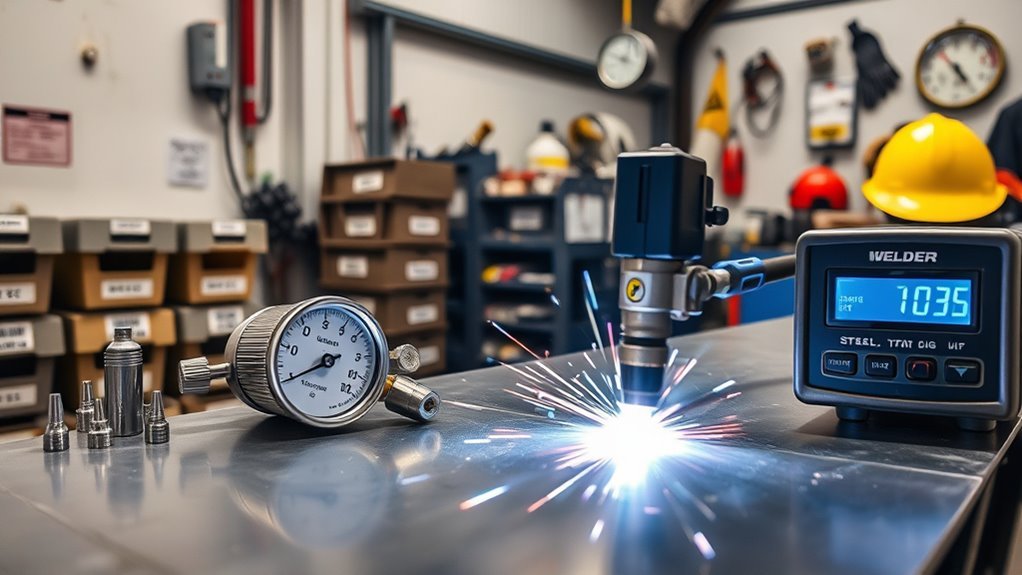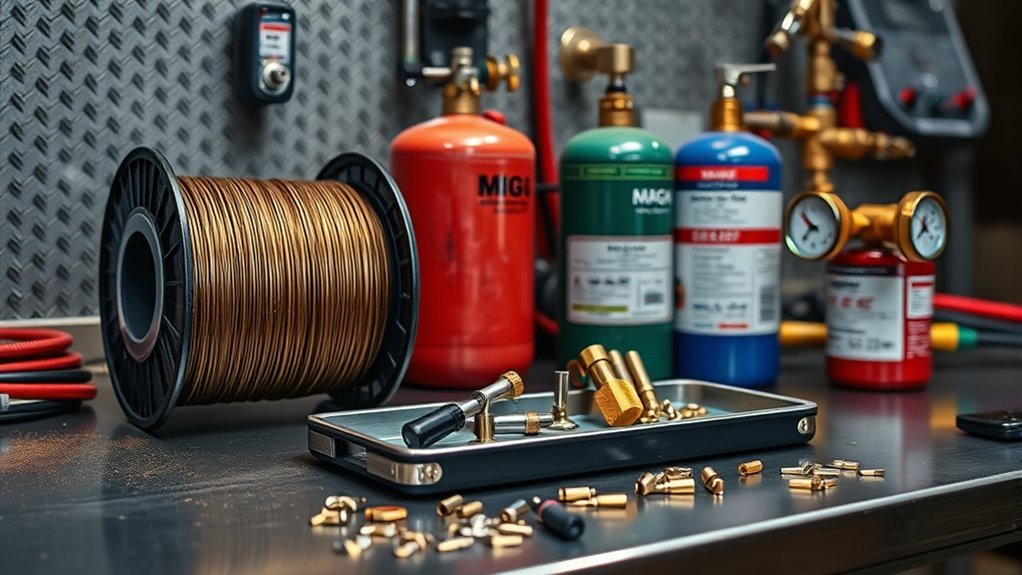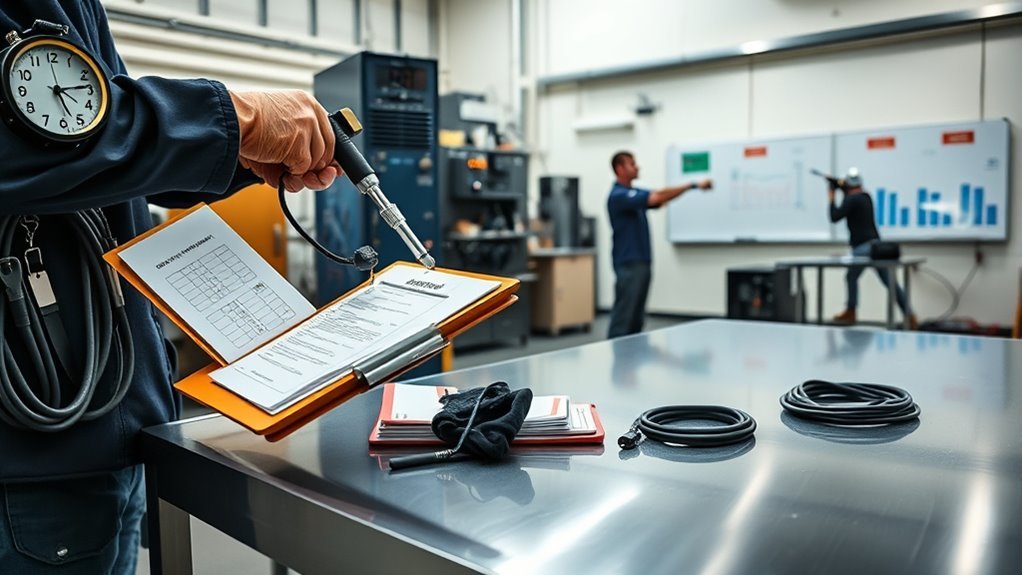You’re budgeting a MIG weld job, and costs hinge on specific choices: machine class, wire type and spool size, shielding gas, labor rate, and deposition efficiency. Entry welders might spend a few hundred dollars on gear; shops factor $65–$125 per labor hour plus consumables like $64 for a 44 lb wire spool and ~$40 for a 200 cf gas refill. Those basics matter — but the real total depends on yield, rework, and throughput, so keep going to see how it all adds up.
Overview of Factors That Determine MIG Welding Costs

Cost drivers for MIG welding boil down to materials, consumables, labor, equipment and process efficiency; you’ll pay more for aluminum or specialty alloys, premium filler wire and shielding gases, and experienced welders whose rates typically fall between $65 and $125 per hour.
When you perform cost estimation, first quantify base material costs: aluminum and exotic alloys command higher per-pound prices and may require specific wire types and gas mixes.
Add consumables: contact tips, nozzles, and flux or shielding gas volumes—premium gases improve arc stability but raise per-hour operating costs and refill frequency.
Factor labor using skill level and joint complexity; more intricate welds increase time and hourly charges.
Account for process efficiency: MIG welding’s high deposition rates and reduced rework lower net material use, improving unit cost.
Finally, include recurring items like gas refills and maintenance in your cost estimation to avoid underbudgeting and to produce a reliable project-level price.
Breakdown of Equipment Expenses for MIG Welding

You’ll find welder machine costs vary widely, from about $300 for entry-level units to over $1,000 for industrial-grade systems, with power output and features driving price.
Expect recurring consumable expenses—filler wire (~$64 per 44 lb spool) and shielding gas—to add to per-project costs.
Factor in maintenance, repair and accessory budgets, because higher-quality machines typically reduce long-term downtime and total cost of ownership.
Welder Machine Costs
A typical MIG welder you’d consider will range from about $300 for entry-level units to well over $1,000 for industrial-grade machines, with price scaling closely to power output, duty cycle, and feature set. You’ll evaluate welder types (inverter, transformer, multi-process) and machine brands for rated amperage, duty cycle, and control precision. Higher wattage and longer duty cycles push cost upward; expect maintenance and repair allocations in your budget. Invest in quality to reduce downtime and material waste. Below is a concise comparison to guide purchase decisions:
| Category | Entry-Level (~$300) | Industrial (>$1,000) |
|---|---|---|
| Power/Duty | Low/Short | High/Long |
| Features/Controls | Basic | Advanced, precise |
Consumables and Gases
Because consumables directly drive per-foot weld expenses, you should budget wire and shielding gas as primary recurring costs for MIG work.
Expect a 44 lbs spool of MIG wire near $64 and a 200 cf shielding gas refill around $40; those figures set baseline material cost.
With consumption rates showing only 12–20 ft lost during wire changes, waste is low and predictable.
Quality filler typically commands higher price but yields better deposit integrity and reduces rework, improving cost efficiency.
At about $1.45 per pound deposited for MIG wire versus $2.93 for stick, MIG delivers measurable savings on material-per-deposit unit.
You should track spool usage and bottle refills to model per-project consumable budgets accurately.
Maintenance and Accessories
When you budget MIG welding, factor in both upfront equipment costs—ranging roughly $300–$1,000 for basic units and above $1,000 for industrial models—and the steady maintenance and accessory expenses that follow.
You’ll plan maintenance schedules based on usage: light hobby work may need quarterly checks, while production shops require monthly inspections.
Consumables (44 lb wire ≈ $64) and shielding gas refills (~$40 per 200cf bottle) are recurring line items.
Replace contact tips, nozzles, liners and drive rolls per manufacturer intervals to avoid downtime.
Allocate $50–$300+ for essential welding gear (helmet, gloves, jackets) depending on feature set.
Consumables and Material Costs (Wire, Gases, Flux)

When budgeting consumables you’ll want to compare wire type and diameter — a 44 lb spool commonly runs about $64 and drives deposition costs near $1.45 per pound.
You should also account for shielding gas selection and refill rates — a 200 cf bottle refill is roughly $40 and argon/CO2 mixes affect both cost and weld quality.
Finally, consider flux and overall consumable life: MIG achieves 95–98% deposition efficiency with minimal wire loss (12–20 ft per change), reducing material waste versus stick welding.
Wire Type and Diameter
One key cost driver in MIG welding is the choice of wire type and diameter, since a 44 lb spool can run about $64 and diameter changes deposition rate and travel speed.
You’ll select wire type (ER70S-6, stainless, flux-cored) based on base metal and mechanical requirements; each carries different unit costs and deposition efficiencies.
Wire diameter directly controls deposition rate: .030″ for thinner sections yields lower metal throughput and slower travel speed; .045″ for thicker sections increases deposition, reducing arc time per joint.
That affects spool consumption, labor hours, and joint fit-up.
Include flux and gas compatibility when specifying wire type and wire diameter to optimize cost per pound of deposited weld metal and overall project economics.
Shielding Gas Choices
Because shielding gas both controls weld chemistry and represents a recurring consumable cost, you should factor gas selection into per-joint and per-project pricing.
Gas selection drives arc stability, penetration and spatter; common options are pure CO2 for cost-sensitive ferrous work and argon/CO2 blends for improved bead profile. A 200cf bottle typically costs about $40 and recurs per project, so calculate cost-per-foot using bottle volume and deposition rate.
The widespread 75% argon / 25% CO2 blend balances weld quality and expense; altering blend ratios (e.g., 90/10 or 80/20) changes arc characteristics and may justify higher gas cost via reduced rework.
Include gas consumption, bottle refill logistics and blend ratios when estimating total consumable costs alongside wire.
Flux and Consumable Life
Shielding gas selection affects more than arc characteristics; it also influences flux usage and overall consumable life, so include gas consumption when calculating flux and wire replacement intervals.
When you apply flux management, recognize GMAW deposition efficiency of 95–98%: you’ll need roughly 105 lbs of filler versus 143 lbs for stick, reducing material spend. A 44 lb MIG spool at about $64 yields lower cost per pound and minimal waste—typically 12–20 ft lost per change—while stick produces heavy slag and only ~30 usable lbs from 50 lbs.
Factor recurring shielding gas cost (~$40 per 200cf fill) into per-hour consumable rates. Small discarded clips and high consumable efficiency cut disposal and replacement frequency, improving total cost metrics.
Labor, Training, and Certification Expenses

When you budget for MIG welding projects, plan for labor, training, and certification to dominate costs—labor alone can represent about 85% of total project expenses, while formal training programs typically run $2,000–$15,000 over six months to two years.
You’ll evaluate labor as direct weld time plus prep and cleanup; skilled MIG welders charge roughly $65–$125/hour depending on experience, certifications, and location.
Invested training delivers measurable welding career and training benefits: higher throughput, fewer defects, and faster setup, which lower effective labor hours per unit. Certification improves marketability and justifies premium rates while reducing rework risk.
Model ROI by comparing upfront program costs and ongoing hourly rates against projected reductions in cycle time and scrap. For contracting or shop pricing, include certification-maintenance costs and periodic retraining.
Use conservative estimates for initial bids, then adjust as operator competency and process controls reduce labor variance and increase predictable quality.
Calculating Cost Per Pound and Deposition Efficiency

Having planned labor, training, and certification costs, you now quantify material efficiency to complete your per-pound weld cost model.
Use deposition metrics: GMAW delivers 95–98% welding efficiency versus SMAW’s 68–70%, so for an equivalent weld you’ll need ~105 lbs of GMAW filler instead of ~143 lbs of SMAW. That efficiency differential drives the published cost-per-pound: roughly $1.45 for deposited GMAW weld metal versus $2.93 for SMAW.
In practical terms, higher deposition efficiency and faster weld rates (skilled MIG: >16 in/min) reduce filler consumption and cycle time, improving throughput and lowering unit cost in your cost analysis.
Waste is also lower: typical MIG changeover losses are only 12–20 ft of wire.
For project estimates, calculate required filler mass by dividing targeted deposited weight by deposition efficiency, then multiply by wire unit cost to derive material cost-per-pound of deposited weld.
This yields a precise, reproducible figure for budgeting and process decisions.
Hidden and Ongoing Operational Costs

Although MIG’s higher deposition efficiency lowers filler needs, you still need to budget for a set of ongoing operational costs that quietly add to per-pound weld expense. You’ll face hidden expenses: shielding gas (~$40/200cf), wire consumables (~$64/44 lb spool; ~$1.45 deposited-lb), electricity for machines, and maintenance/repairs. Those line items erode operational efficiency if you don’t track usage rates and downtime. Cleanup time is reduced versus stick welding, which improves labor productivity, but you must still allocate hours for preventive maintenance and occasional repairs.
| Cost Type | Typical Unit Cost | Impact on Per-Pound |
|---|---|---|
| Shielding gas | $40 / 200cf | Raises variable cost per weld |
| Wire consumables | $64 / 44 lb | ~$1.45 deposited-lb |
| Electricity | Varies by use | Significant for heavy users |
| Maintenance/repairs | Budgeted allowance | Prevents downtime |
| Labor (cleanup) | Lower than stick | Improves operational efficiency |
Cost Comparison: Manual Versus Robotic MIG Welding

Because labor typically makes up the largest portion of welding cost, choosing between manual and robotic MIG changes your per-weld economics dramatically: manual skilled operators run roughly $65–$125/hour and offer flexibility for complex parts, while robotic cells require $30,000–$100,000+ capital but cut labor hours and deliver lower cost-per-weld in high-volume runs.
You’ll favor manual advantages when part complexity, low volumes, or frequent changeovers make capital recovery impractical; manual setups have lower upfront cost and handle fixturing variability without expensive programming.
Conversely, robotic efficiency shows in repeatable deposition (95–98% material efficiency), reduced cycle times, and stable quality, shrinking variable labor and rework expenses.
Robotic MIG delivers consistent deposition (95–98% material efficiency), faster cycle times, and steadier quality, cutting labor and rework costs.
Account for higher maintenance and integration costs for robots, but model payback using throughput, weld time per part, and material yield improvements.
Run breakpoint analysis: calculate welded parts-per-year where robot total cost (capital amortized + maintenance + residual labor) drops below manual labor plus scrap. That quantitative comparison determines the economically preferable choice.
Strategies to Reduce MIG Welding Costs

When you focus on consumable quality, equipment upkeep, operator training, and strategic purchasing, you can cut MIG welding costs materially—typically by reducing wire consumption, downtime, and labor hours per weld.
Invest in higher-grade MIG wire and shielding gas: MIG wire averages ~$1.45/lb versus $2.93/lb for stick, and better filler chemistry increases deposition efficiency, reducing cost per weld.
Schedule preventive maintenance and enforce correct machine settings to minimize failures and unscheduled downtime that inflate per-part cost.
Train operators to maximize travel speed, correct stick-out, and appropriate voltage/amp settings—skilled MIG welders lift deposition rates and reduce labor minutes per joint.
Use bulk purchasing for consumables and larger spools to lower unit cost per foot; model the payback from spool-size versus inventory carrying cost.
Establish supplier partnerships (for example, Meritus Gas Partners) to secure volume discounts, technical support, and optimized gas-consumable bundles.
Combine these tactics to lower total cost of ownership and drive measurable reductions in cost-per-weld.
Frequently Asked Questions
Can MIG Welding Be Used Effectively on Exotic Metals Like Titanium?
Yes — you can use MIG welding for titanium applications, but you’ll need controlled shielding, inert gas trailing, clean prep, specialized wire and power settings; assess welding process challenges and exotic metals suitability for strength, contamination risk, and joint integrity.
How Does Climate (Humidity, Temperature) Affect MIG Weld Quality?
Humidity over ~60% raises porosity risk by 30%, so you’ll control welding conditions tightly. Temperature and humidity affect gas shielding, cooling rates and environmental impact on weld chemistry; adjust parameters and preheat to maintain quality.
Are There Special Disposal Requirements for Spent Shielding Gas Cylinders?
Yes — you must follow cylinder disposal rules for spent shielding gas cylinders: depressurize, tag, return to supplier or recycle per DOT/EPA regs, remove valves, document transfers, and handle inert, flammable, or toxic gases per specific MSDS instructions.
Can Hobbyists Legally Operate Robotic MIG Welders at Home?
Yes — you can, but rules vary: robotic welder regulations differ by jurisdiction, so you’ll check local codes, secure permits, follow hobbyist safety protocols, document compliance, maintain training records and use proper ventilation, guards, and PPE.
What Insurance or Liability Concerns Apply to Mobile MIG Welding Services?
You need liability coverage and commercial general liability; consider insurance types like professional liability, auto-for-hire, and inland marine for equipment. Verify limits, deductibles, exclusions, and worker’s comp to manage claims, property damage, and bodily injury risk.
Conclusion
You’ll see MIG welding costs vary because equipment, consumables, and labor dominate the equation — but test the idea that buying pricier gear always saves money. Data show higher-capacity machines and better wire can improve deposition efficiency and cut rework, yet upfront capital and skilled hourly rates often outweigh savings for low-volume work. Run a simple ROI: compare hourly labor plus consumables to projected productivity gains before choosing equipment or automation.


